



The name Auschwitz has become a powerful symbol of unspeakable crimes, horror and death. Of course I'd heard of the atrocities committed here, the largest death camp in the Third Reich, even studied them at school.But it wasn't until I stared at seven tonnes of hair that had been shorn from the heads of prisoners, or looked at hundreds of tiny shoes that had been taken from the feet of dead children, that the enormity of what happened here really struck me - knocked me flat, in fact.In the past week weve travelled across Poland, from the capital Warsaw down to Krakow and into the Tatra mountains in Zakopane.This whole trip has been a lesson in history, particularly in Eastern Europe as we jump from one former soviet country to another.But the one place that will be seared in my memory is Auschwitz, where between 1.1 and 1.5 million people - mainly Jews but also Soviets, political prisoners and gypsies - were exterminated.There's no sorrowful soundtrack or multimedia gimmicks here to induce emotion, because there's no need. Everything is stripped bare – from the remnants of the gas chambers and the poisonous zyklon B containers to the bare prisoners barracks.The immortal inscription Arbeit Macht Frei - work makes you free – looms over the gate at the entrance. Thousands of prisoners would have been herded under this sign, which mocked them as they marched towards almost certain death.The most disturbing exhibit is a room containing mountains of human hair. Time has left it aged and matted, but look closely and you can spot long plaits scattered here and there amongst the seemingly endless piles. The human hair was to be transported to Germany and made into cloth.As prisoners arrived they were also stripped of their personal possessions. On show are piles of artificial limbs, suitcases, glasses, shaving brushes, and the shoes. Inside the jumble I saw what looked like a pair of small cowboy boots, and a ballet slipper. Two camps actually make up the Auschwitz-Birkenau Memorial and Museum: Auschwitz I and Auschwitz II-Birkenau.The second camp, Birkenau, is where most of the prisoners were executed. A set of train tracks leads through the red-brick entrance, ending ominously inside the camp.The prison barracks spread as far as they eye can see, but the most chilling section is at the back of the camp where the remnants of the old gas chambers remain. So cunning were the Nazi officers that they told the prisoners they would be taking a shower inside, even handing out bars of soap to the clueless prisoners. With the Soviets advancing and desperate for no-one to find out about their atrocities, the fleeing Nazis bombed the gas chambers in 1945, so all that remains now are bricks and a bare outline of where the thousands perished.In a room near the gas chambers is an exhibition of photographs taken from the suitcases of the victims; there are two men posing for portrait with large cigarettes poking comically out their mouths; a family photographed beside a person in a bear costume; a child of about four wearing a suit and grinning at the camera while confidently clutching his lapels. As our guide said at the end of a five-hour tour – at least this is history, and we can be hopeful for the future.With survivors of the Holocaust gradually passing away, Auschwitz as a physical link to this chilling past. It serves as both a reminder, and a warning.
Subscribe now for unlimited access.
$0/
(min cost $0)
or signup to continue reading

